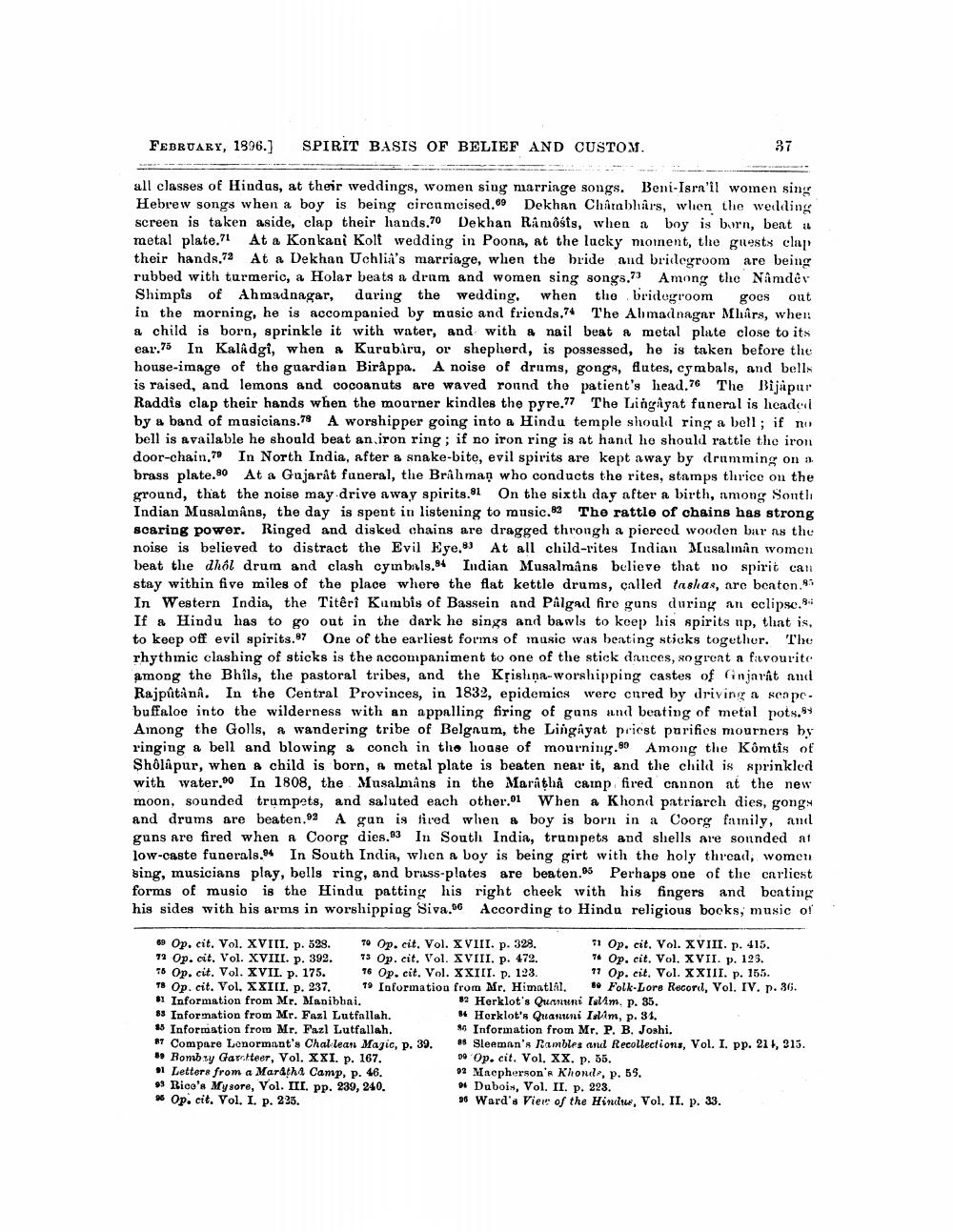________________
FEBRUARY, 1896.] SPIRIT BASIS OF BELIEF AND CUSTOM.
all classes of Hindus, at their weddings, women sing marriage songs. Beni-Isra'll women sing Hebrew songs when a boy is being circumcised. Dekhan Chambhars, when the wedding screen is taken aside, clap their hands.70 Dekhan Râmôśis, when a boy is born, beat 24 metal plate. At a Konkani Kolt wedding in Poona, at the lucky moment, the guests clap their hands.72 At a Dekhan Uchlia's marriage, when the bride and bridegroom are being rubbed with turmeric, a Holar beats a drum and women sing songs.73 Among the Nâmdêv Shimpis of Ahmadnagar, during the wedding, when the bridegroom goes out in the morning, he is accompanied by music and friends.74 The Ahmadnagar Mhars, when a child is born, sprinkle it with water, and with a nail beat a metal plate close to its ear.75 In Kalâdgi, when a Kurubaru, or shepherd, is possessed, he is taken before the house-image of the guardian Birâppa. A noise of drums, gongs, flutes, cymbals, and bells is raised, and lemons and cocoanuts are waved round the patient's head.76 The Bijapur Raddis clap their hands when the mourner kindles the pyre." The Lingayat funeral is headed by a band of musicians.78 A worshipper going into a Hindu temple should ring a bell; if no bell is available he should beat an iron ring; if no iron ring is at hand he should rattle the iron door-chain. In North India, after a snake-bite, evil spirits are kept away by drumming on a brass plate.90 At a Gujarât funeral, the Brahman who conducts the rites, stamps thrice on the ground, that the noise may drive away spirits. On the sixth day after a birth, among Sonth Indian Musalmâns, the day is spent in listening to music.82 The rattle of chains has strong scaring power. Ringed and disked chains are dragged through a pierced wooden bar as the noise is believed to distract the Evil Eye. At all child-rites Indian Musalman women beat the dhol drum and clash cymbals.84 Indian Musalmâns believe that no spirit can stay within five miles of the place where the flat kettle drums, called tashas, are beaten.85 In Western India, the Titêri Kumbis of Bassein and Pâlgad fire guns during an eclipse. 8 If a Hindu has to go out in the dark he sings and bawls to keep his spirits up, that is, to keep off evil spirits.87 One of the earliest forms of music was beating sticks together. The rhythmic clashing of sticks is the accompaniment to one of the stick dances, so great a favourite among the Bhils, the pastoral tribes, and the Krishna-worshipping castes of Ginjarât and Rajputana. In the Central Provinces, in 1832, epidemics were cured by driving a scapebuffaloe into the wilderness with an appalling firing of guns and beating of metal pots. Among the Golls, a wandering tribe of Belgaum, the Lingayat priest purifies mourners by ringing a bell and blowing a conch in the house of mourning.89 Among the Kômtis of Sholapur, when a child is born, a metal plate is beaten near it, and the child is sprinkled with water.90 In 1808, the Musalmâns in the Maratha camp fired cannon at the new moon, sounded trumpets, and saluted each other.01 When a Khond patriarch dies, gongs and drums are beaten.93 A gun is fired when a boy is born in a Coorg family, and guns are fired when a Coorg dies.83 In South India, trumpets and shells are sounded at low-caste funerals. In South India, when a boy is being girt with the holy thread, women sing, musicians play, bells ring, and brass-plates are beaten.95 Perhaps one of the carliest forms of music is the Hindu patting his right cheek with his fingers and beating his sides with his arms in worshipping Siva. According to Hindu religious bocks, music of
69 Op. cit. Vol. XVIII. p. 528. 72 Op. cit. Vol. XVIII. p. 392. 75 Op. cit. Vol. XVII. p. 175. 18 Op. cit. Vol. XXIII. p. 237. 81 Information from Mr. Manibhai.
83 Information from Mr. Fazl Lutfallah.
85 Information from Mr. Fazl Lutfallah.
87 Compare Lenormant's Challean Magic, p. 39.
89 Bombay Garetteer, Vol. XXI. p. 167.
91 Letters from a Maratha Camp, p. 46. 93 Rico's Mysore, Vol. III. pp. 239, 240. Op. cit. Vol. I. p. 225.
70 Op. cit. Vol. XVIII. p. 328. 73 Op. cit. Vol. XVIII. p. 472. 76 Op. cit. Vol. XXIII. p. 123. 19 Information from Mr. Himatlil.
1 Op. cit. Vol. XVIII. p. 415. 7 Op. cit. Vol. XVII. p. 123. 17 Op. cit. Vol. XXIII. p. 155. se Folk-Lore Record, Vol. IV. p. 36.
82 Herklot's Quanuni Islam. p. 35. 84 Herklot's Quanuni Idim, p. 34.
86 Information from Mr. P. B. Joshi.
37
88 Sleeman's Rambles and Recollections, Vol. I. pp. 21, 215.
99 Op. cit. Vol. XX. p. 55.
92 Macpherson's Khonde, p. 55.
94 Dubois, Vol. II. p. 223.
96 Ward's View of the Hindus, Vol. II. p. 33.




